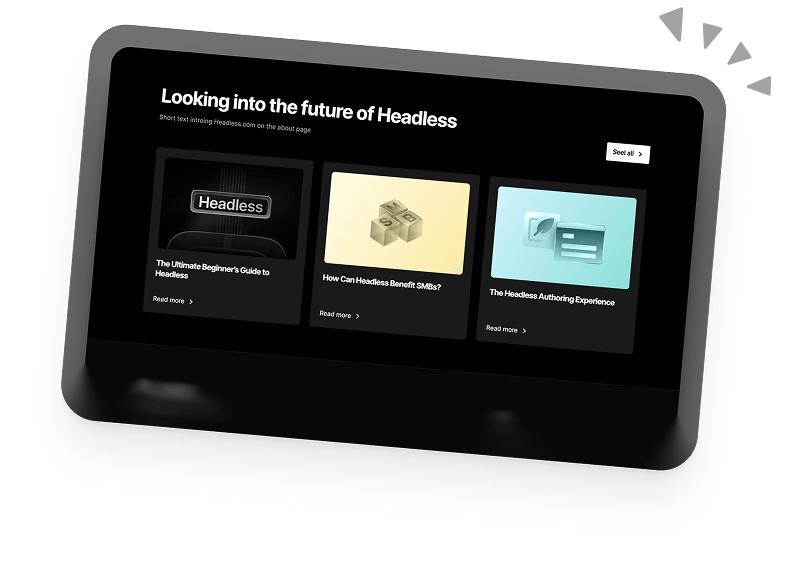7 Key Benefits of Headless Commerce
Looking to stay ahead of the competition and give your customers a seamless shopping experience?
Then it’s time to consider a Headless commerce architecture.
Headless commerce is a modern approach to eCommerce that offers increased flexibility, enhanced performance, and improved customer experiences.
But what exactly is Headless commerce? And how can it benefit your business? In this guide, we’ll answer these questions and more.
By the end of this article, you’ll have a deep understanding of Headless commerce and its potential impact on your business. So, whether you’re a small eCommerce startup or a large enterprise, learn how Headless commerce can take your business to the next level.
What is Headless Commerce?
Headless commerce is an e-commerce platform that separates the store’s appearance (frontend presentation layer) from how it works (backend commerce engine). In Headless commerce, the frontend and backend are decoupled and use APIs to communicate and share data.
This separation enables businesses to choose the best technologies, platforms, and frameworks for their needs without being limited by a specific commerce engine or frontend technology.
When implemented, Headless commerce grants the flexibility to use a variety of backend systems based on your needs, including content management systems (CMS), customer relationship management (CRM), progressive web apps (PWA), and digital experience platforms (DXP).
The Growth and Expansion of Headless
As more businesses adopted Headless commerce to address their unique needs, the ecosystem expanded and progressed. The emergence of popular frontend frameworks such as React, Vue.js, and Angular, along with robust APIs and content management systems, also contributed significantly to the growth of Headless commerce.
The rising demand for multi-channel strategies prompted more businesses to embrace Headless commerce, as it facilitated seamless integration across multiple platforms and devices. As a result, many Headless commerce platforms like Shopify Plus, BigCommerce, Magento, and CommerceTools emerged, each offering special features to meet various business requirements.
The Current State of Headless Commerce
Today, Headless commerce has become a popular choice for businesses. One survey reported that 61% of retailers had either already implemented a Headless commerce solution or were planning to.
Some of the latest innovations in Headless commerce include using artificial intelligence to personalise shopping experiences, using voice commands, and integrating with IoT (Internet-of-Things) devices.
Overall, Headless commerce has come a long way since its early days. Its continued growth and innovation make it an excellent option for businesses looking to create unique and flexible online shopping experiences across multiple platforms.
The Core Components of Headless Commerce
To understand how Headless commerce works, let’s break down its four core components:
Frontend presentation layer
The frontend presentation layer is the part of your website that your customers interact with. The user interface displays all your content, products, and promotional materials. With Headless commerce, the frontend is detached from the backend, which means you can use any technology or framework to build the user interface.
This separation allows for a more streamlined, customised experience for your users, as frontend developers can focus solely on the design and user experience without being tied to any specific backend commerce engine.
Backend commerce engine
The backend commerce engine is responsible for all the behind-the-scenes work, including processing transactions, managing inventory, and handling customer data. In Headless commerce, this engine operates independently of the frontend presentation layer, which can be updated or changed without affecting the user interface.
This independence allows businesses to choose the best backend engine for their needs, whether that’s a custom-built solution or a third-party platform.
APIs and integrations
APIs (Application Programming Interfaces) bridge the frontend presentation layer and the backend commerce engine. They enable the two components to communicate and exchange data, ensuring a smooth customer experience. Integrations are crucial in Headless commerce because they allow your front end to access all the necessary information from your back-end, like product data, pricing, and customer information. With APIs, you can easily integrate with other tools and systems, enhancing your site’s functionality and capabilities.
Content management systems
Content management systems (CMS) allow you to create, edit, and manage content without touching the code. In a Headless commerce setup, the CMS is typically decoupled from the front end and back end, meaning you can choose the best CMS for your needs without being limited by your commerce engine or frontend technology. Popular CMS options for Headless commerce include Contentful, Strapi, and Sanity.
Headless Commerce vs Traditional Commerce
| Features | Headless Commerce | Traditional Commerce |
| Customization | High level of customization | Limited customization options |
| Flexibility | Greater flexibility | Less flexible |
| Development Speed | Faster development, as frontend and backend can be developed independently. | Slower development due to dependencies between the frontend and the backend. |
| Technology Stack | Freedom to choose any technology for the front-end | Technology stack dependent on the e-commerce platform |
| Omnichannel Capabilities | Better support for omnichannel experiences | Limited support for omnichannel experiences |
| SEO & Performance | Greater control over SEO and performance optimizations. | Less control over SEO and performance optimisations |
| Scalability | More scalable due to decoupled architecture | Scalability may be limited due to platform restrictions |
| Integration | Easy integration with othersystems and tools using APIs | Integration with other systems may be more challenging. |
| Cost & Complexity | Potentially higher initial costs and complexity but more cost-effective in the long run. | Lower initial costs and complexity but may be more expensive in the long run. |
Headless commerce offers greater customization, flexibility, and control over SEO and performance optimizations. It also supports omnichannel experiences more effectively and can be more scalable due to its decoupled architecture. However, it may come with higher initial costs and complexity.
On the other hand, traditional commerce may have lower initial costs and complexity but offers less flexibility and has limited support for omnichannel experiences.
Benefits of Headless Commerce
Let’s explore the key benefits of adopting a Headless commerce approach and how it can positively impact your business:
Enhanced Customization
Headless commerce gives you complete control over your online store’s design and user experience. This allows for greater customization, ensuring that the user interface reflects your brand’s unique identity and meets the needs of your target audience.
Flexible Tech Stacks
Decoupling the frontend and backend components allows you to choose the best technologies, platforms, and frameworks for your specific needs. This makes it easier to adapt to changing market conditions and evolving customer preferences. For instance, you can easily switch between different frontend frameworks or backend systems without disrupting the entire site.
Faster Time-to-Market
In a Headless commerce setup, your frontend and backend development teams can work simultaneously, speeding up the development process and shortening the time to market for new features and updates. This means you can introduce new products, promotions, or site improvements more quickly, keeping your customers engaged and satisfied.
Better Omnichannel Experiences
Headless commerce allows for easy integration across multiple platforms and devices. So, it’s easier to deliver consistent and engaging omnichannel shopping experiences.
An excellent example of omnichannel Headless commerce is Nike. They integrated PWAs and mobile apps with in-store shopping for a truly seamless CX with their Nike Live stores. These stores let customers use a mobile app to scan products for more information and earn rewards. The stores also offer localised products based on the store’s location.
Scalability
The decoupled architecture of Headless commerce makes it easier for you to scale your online store without the constraints of a traditional commerce platform. As your traffic and customer base expands, you can scale your backend infrastructure to handle the increased demand, ensuring that your site remains fast and responsive for all users.
Easier Integrations
The API-based architecture of Headless commerce makes it easier to connect your site with other systems and tools.
You can extend your site’s functionality and capabilities by connecting to customer relationship management (CRM) software, marketing automation platforms, inventory management systems, and more. These integrations help streamline your business processes and enhance your customer experience.
Future-Proof
Headless commerce lets you keep ahead of the curve, easily adopting new technologies to keep your business innovative.
The flexible integration options means your store can remain competitive and relevant in an ever-changing digital landscape. As your business grows and new commerce trends pop up, you’ll be able to adapt and scale as needed. Whether it’s mobile apps, voice-activated shopping, or augmented reality, you can slap these features into your Headless commerce stack and be good to go.
By embracing this approach, you’ll be better positioned to adapt to changing market conditions, satisfy your customers’ needs, and, ultimately, grow your business.
Get started with Headless commerce
If you want to implement Headless commerce into your business model, then get in touch with us to find out how we can make Headless work for you!
Book a 30-min Introduction Call
Let's jump on a quick intro call We'll break down your project, and pinpoint exactly how we can help.



Our clients  Holaa! love working with us see their stories below!
Holaa! love working with us see their stories below!






